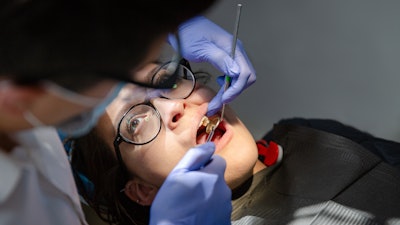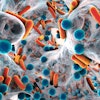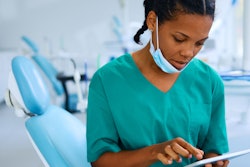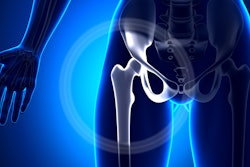
Back in the early to mid-1980s prior to the vaccine availability of hepatitis B, concerns about proper infection control in dentistry emerged. Ungloved dentists, especially oral surgeons, were implicated in the largest number of outbreaks in healthcare settings. One dental outbreak involving an ungloved oral surgeon infected the most number of patients (n = 55) in any healthcare setting. These concerns were only heightened after HIV/AIDS came along.
Our understanding of the transmission of bloodborne pathogens included in 10-6 to 10-9 ml of blood -- a tiny amount -- could transmit hepatitis B infection. An estimated dose of 0.1 ml to 0.001 ml of blood could transmit HIV, the virus that causes AIDS. Based on these facts, when I wrote the first U.S. Centers for Disease Control (CDC) infection control guidelines for dentistry, gloves, masks, and eyewear were recommended for dentists and dental workers when treating patients. We called it, "CDC Sez," or an official recommendation.
Fortunately, with others at the CDC in Atlanta and a few brave souls in Chicago, adoption of these personal protective equipment recommendations became standard in dental practice over the next five years. The Occupational Safety and Health Administration ensured that enforcement of the CDC's voluntary guidelines became mandatory, spurred along by lawsuits by hospital workers demanding that hospital administrators pay for the hepatitis vaccine. Dentistry followed these directives.
Focus on 2020 now, the emergence of COVID-19 brought the issue of indoor air quality and airborne transmission into focus. Sure, we knew about person-to-person transmission of adenoviruses, which cause colds, and influenza virus from airborne transmission, but these were mere annoyances, not life-threatening -- at least for most people.
Still, prior to COVID-19, environmental control guidelines for healthcare focused primarily on room air ventilation that "seemed" to address airborne transmission. These recommendations ensured higher rates of room air exchanges per hour for heating, ventilation, and air conditioning (HVAC) systems, increasing with the length of time that aerosol-generating procedures (AGPs) were performed.
Scientific evidence showed that this was necessary, but it is probably insufficient for the prevention of infections indoors. Based on new science, a group of multidisciplinary global scientists spearheaded efforts to focus more on indoor air quality and the airborne transmission of pathogens in 2020.
These scientists pressed the case for control of airborne transmission of SARS-CoV-2, the virus that causes COVID-19, to the World Health Organization (WHO). Before this time, most research in healthcare settings established that the distribution of large, exhaled particles (100 μm) is concentrated in close proximity to infected individuals, usually about three feet, hence the recommendation for wearing masks within three feet of a patient. Since we don't know who is infected and who is not, that means masks and eyewear by dental workers for every patient.
The main concern that advocates wanted was for WHO to address the risks of airborne transmission, those smaller particles (0.5 μm, the size of SARS-CoV-2) that may remain suspended in the air for up to 41 hours, which can be dispersed, traveling five to 10 feet or more, depending on indoor air currents. Not just in healthcare, but in any indoor space.
On April 18, WHO released its technical report after more than two years of deliberations by a team of multidisciplinary scientists. Instead of using the term "aerosols" for those particles at or below 5 μm and "droplets" for those large particles that were bigger and often settled quickly on the ground, often in a few seconds, WHO proposed a new term -- "infectious respiratory particles" -- for all-sized particles, small to large. So, with this new way of viewing the world of indoor air, the risk of transmitting COVID-19 is greater for breathing through airborne inhalation, with a smaller risk from direct deposition of large droplets to uninfected persons nearby.
What does this mean for dentistry? For the next pandemic, we will see less confusion, more early masking, and more emphasis on ventilation. In the meantime, looking at the new international indoor air quality standard, ASHRAE Standard 241, for HVAC systems might be good. Products that have met this standard for testing with the bacteriophage MS-2 should be considered for dental offices and other healthcare facilities. In the meantime, we should think more about protecting ourselves, our employees, and our patients with better indoor air quality.
For the future, we need to continue scientific research to address the risks of any AGPs and the risks of transmission for acquiring infectious diseases from respiratory infectious particles. We also need to think about new and emerging infections, as well as some existing infections that are resurging, like measles.
The measles virus can spread with high transmission efficiency to infect about 90% of unvaccinated individuals. It can remain in the air for hours after an infected patient leaves, and a person is infected and should be quarantined for 21 days, as they are considered infectious. That means we need to pay more attention to indoor air quality and AGPs for now.
WHO's report leaves some questions. What this does is answer the question about the need to pay more attention to airborne transmission of infections in dental offices, not just blood-borne infections.
Editor's note: References are available upon request.
Dr. Margaret Scarlett is a dentist, futurist, population health expert and co-founder and chief science officer of Dental Transformation Partners, a company focused on helping launch the next generation of innovations that will transform dentistry and ensure that oral health is recognized as a critical component of overall health by providers and patients alike. Scarlett is a member of the ADA Standards Committee on Artificial Intelligence in Dentistry and a contributor to the December 2022 ADA whitepaper "Overview of Artificial and Augmented Intelligence Uses in Dentistry." She transitioned to private practice after 23 years in the U.S. Public Health Service Commissioned Corps, the U.S. Centers for Disease Control and Prevention, and the U.S. Army. Her career focus has been on health and overall health outcomes through population health data for chronic and infectious diseases.
The comments and observations expressed herein do not necessarily reflect the opinions of DrBicuspid.com, nor should they be construed as an endorsement or admonishment of any particular idea, vendor, or organization.



















